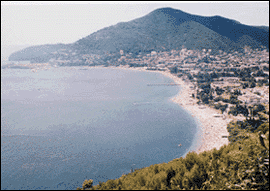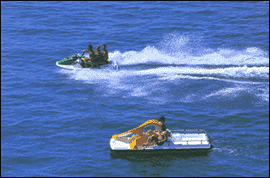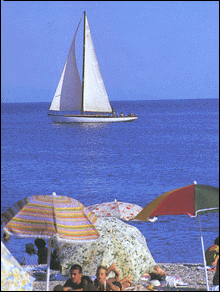 "WILD BEAUTY" "WILD BEAUTY" |

The final piece of the puzzle is tourism. In 1990, Montenegro hosted 11 million overnight stays and 35% of the total numbers were foreign tourists. It was a well-known destination for German, British, Scandinavian, and Benelux tourists.
Yet tourism numbers fell drastically after the split of former Yugoslavia and civil wars in Bosnia, Croatia and Kosovo.
"In 1992, we completely lost the foreign market and the country was isolated", recalls Ivo Armenko, Managing Director of Budvanska Rivijera, the leading hotel chain on the Adriatic coast.

Today, even though the situation is back to normal, Montenegro's tourism infrastructure has suffered; hotels are in need of investment and the country needs to renew its image.
It was therefore important to launch a campaign to revive tourism to the country, and on November 2nd, 2001, the Montenegrin Government adopted a Master Plan for Tourism that defines its development strategy, taking into consideration both the experiences of competitive destinations and the new trends in demand coming from European markets.
"We have established a strategy for the development of Montenegrin tourism for the next 20 years" announces Predrag Nenezic, Minister of Tourism.

Financial support and cooperation by the German Investment and Development Company (DEG) and the Credit Institute for Reconstruction (KfW) has given a boost to the Master Plan, which proposes to develop Montenegro into a top-quality holiday destination in the Mediterranean.
"We were known as a cheap, low-budget destination in the Mediterranean", says Nenezic. His goal is to develop Montenegrin tourism at the level of Mallorca in Spain, by increasing capacity and quality in all related tourism services. | For the time being, Montenegro has only 5,000 beds to offer to foreign tourist from western and northern Europe. The plan is to gradually increase that number. "According to official statistics, there are currently 74,000 tourists but we assume that there are about 150,000 and only 10% are foreigners", says Nenezic.
In order to increase tourism numbers, Montenegro also plans to extend the season and to change the structure of tourists. In 10 years Montenegro plans to attract 50% f its tourist base from abroad, and hopes to increase that figure to 75% in 20 years.
Water supply will also be improved through a project coordinated with the coastal municipalities and the old capital of Cetinje. "According to our estimates, the water capacities will increase by 30% next year and in three years we will increase supply by 100%. Right now, we have a leakage of more than 70%, so we have to reconstruct the existing water networks and improve the system from Skadar Lake. There is already more than DM 60 million invested into this project" says Mr. Nenezic.
Croatia has experienced high growth and showed that tourism can be revived in the region. Yet Montenegro actually has a more complete package to offer: beaches on the coast, the central part, the northern part, three areas, two different climates, three or four different religions and different cultures throughout history. In northern Montenegro, Boka Kotorska lies on the border with Croatia and represents complementary destination for all visitors to the Dubrovnik area. It is a UNESCO protected heritage site. On the southern coast of Montenegro, the 12-kilometre beach of Ada Bojana lies at the border with Albania and has a great development potential.

Although the initial focus will be on adventure and cultural tourism, new investment projects will focus on high-end facilities in order to develop a sophisticated destination package "The future of tourism is in high quality" says Armenko.
Indeed, the potential for quality in Montenegro is perfectly illustrated by the list of guests who stayed at the exclusive "Sveti Stefan" resort: they include Sofia Loren, Monica Viti, Alberto Moravia, Richard Burton, Elisabeth Taylor, Bjorn Borg, and the top model Claudia Schiffer.
A first priority will be the attraction of foreign direct investment through an attractive package of privatization schemes. "There is already an attractive legal framework for foreign investments, and we are currently working on investment incentives" says Nenezic, adding that the privatization process is already under way. "Tenders were launched for major stakes in all companies and for major hotels on a case by case basis".
In fact, the Hotel Maestral, located on the Adriatic coast, was recently sold to a Slovenian company, while companies like Starwood and investors from Austria, England and Russia are in high-level talks.
Business hotels like the Crna Gora Hotel in Podgorica are also on the privatization list, proposing an ambitious plan "to increase its capacity and profitability in order to return the means invested into its modernization, reconstruction, and expansion" says Radomir Zec, Managing Director of UTIP Crna Gora DD, a chain of hotels which is looking to fully develop Montenegro's tourism potential. "We need a lot of know-how and management", adds Zec.
This year the interest of tour operators is also starting to peak, and business is looking better and better.
"I am sure that next year is going to be the year of our comeback", predicts Armenko. |

